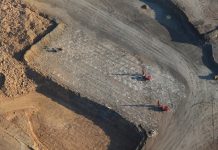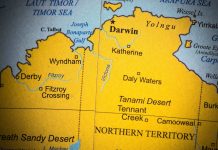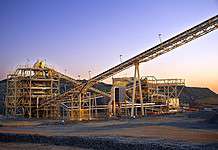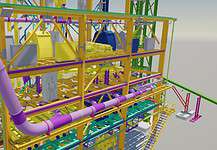THE Tanami region, which straddles the Northern Territory and WA border, has become one of Australia’s foremost gold provinces. With almost all discoveries in the region made since the mid-1980s, it boasts past production and current resources of more than 11 million ounces of gold from mines including Newmont Mining’s highly successful Callie underground operation.
In June 2012, a report by Geoscience Australia highlighted the possibility of additional massive gold deposits in the area, and proposed that the region’s abundant active and historic gold mines formed during one event about 1.8 billion years ago.
“The similarity between the age of gold from the…Coyote mine, along with that for the Callie mine in the Northern Territory, suggest there was a single, region-wide geological event which resulted in the gold
being deposited…[and] indicates that further significant gold deposits may be discovered in the region,” Geoscience Australia geochronologist Dr Geoff Fraser said in a statement accompanying the report.
Australian company Tanami Gold has exploration and mining tenements spanning more than 4341 square kilometres along the WA and Northern Territory border comprising its successful Western Tanami operations and highly-prospective Central Tanami Project (CTP).
Since June 2009, the company has experienced a 350 per cent increase in total resources across its projects to 2.6moz. Including the highly-prospective and company-defining Groundrush deposit at CTP, the resource increase represented a strong platform for long-term sustainable growth.
Western Tanami operations Tanami Gold’s Western Tanami operations comprise the Coyote underground and Bald Hill open pit mines, about 30km west of the WA and Northern Territory border.
Resources stand at a collective 3.104 million tonnes grading 5.4 grams per tonne for 538,000oz, with ore feeding into the 350,000t per annum Western Tanami treatment facility.
Production for the 2011-2012 financial year was about 40,000oz of gold, and the company has announced that it will take steps to increase this to 50,000oz in 2012-2013.
The high-grade Coyote underground mine was commissioned in late 2007, and had resources of 880,000t grading 11g/t for 312,000oz as of September 2011. In the past year, a number of operational improvements at Coyote have resulted in significant production increases, decreased operational costs and a solid underground development program.
Early in the March 2012 quarter, Tanami Gold embarked on a significant capital development program designed to access the new strongly-mineralised West Zone at Coyote.
Two upper development drives were established as part of the program, stoping is under way and decline development down to the next level is nearing completion.
Ore removed from Coyote during the March 2012 quarter came from the upper Bommie, GZ12, and South and West Zone lodes. Development of the lower Gonzales and Bommie lodes was postponed during the March quarter – work resumed in the June quarter – to concentrate activities on the West Zone.
Tanami Gold is continuing its comprehensive diamond drilling campaign at Coyote, with a total of 3335m from 38 holes drilled during the March quarter. Drilling predominately focussed on extension and definition at West Zone and Bommie. Assay results have confirmed the existence of high-grade mineralised shoots that open up multiple new and untested extensions within areas surrounding the existing mine.
Testing of these shoots started in the June 2012 quarter, using a combination of underground and surface drilling.
Assay results from a regional 2011 reverse circulation drilling program reviewed during the March quarter on a number of Western Tanami tenement prospects showed significant results at the Montecristo prospect, where follow up drilling is planned. Results at Montecristo included 4m grading 2.3g/t gold, with the anomaly open for 800m along regional strike and 400m along strike, in an area that has undergone
very little historic exploration. Tanami Gold has planned an air core drilling program for the prospect in the second half of 2012.
Central Tanami Project
Tanami Gold acquired the CTP from Newmont for $22 million in March 2010, and the project could be a decisive step change for the company as it moves toward production at its Groundrush prospect.
The CTP transaction included a JORC-compliant resource of more than 500,000oz, the 1.2mtpa Groundrush treatment plant and extensive support infrastructure, and 2000sqkm of outstanding exploration tenements.
Tanami Gold has targeted CTP production of between 130,000 and 150,000 ounces per annum within three years, predominately from the Groundrush deposit, as it looks to move up the ranks of Australian mid-tier gold producers. Coupled with the CTP’s undeniable exploration potential, the project will remain a primary focus for the company for the immediate future.
In February 2011, Tanami Gold announced a CTP resource of 18.159mt grading 2.5g/t gold for 1.476moz of gold.
While the CTP produced more than 2moz of gold between 1987 and 2005, mostly from 43 open pit mines to an average depth of about 100m, Tanami Gold has reported that it believes the area is considerably underexplored, with less than 2 per cent of historic drilling below 200m. The company has embarked on a bullish exploration program to realise the potential of the CTP, with a long-term view to producing 200,000ozpa through the project’s life. Groundrush Tanami Gold opted to delay the CTP pre-feasibility study (PFS) in the December quarter of 2011, to allow for a more detailed evaluation of resources and reserves at the project’s flagship Groundrush deposit.
At 1.5km long, Groundrush has been the largest producing pit at the CTP, with more than 600,000oz recovered at about 5000oz per vertical metre during mining by Newmont for a three-year period to 2004.
Tanami Gold delineated a 535,000oz resource at Groundrush in 2011, with the deposit remaining open down plunge and down dip.
Exploration continued at Groundrush during the March quarter, including a combination of 24 resource definition and exploration drilling holes for 5893m.
On June 8, 2012, the company announced a 39 per cent (208,000oz) increase in the mineral resource estimate for Groundrush to 743,000oz.
Exploration and infill drilling is ongoing, with several recent successful step-out drill holes not included in the updated resource.
“This interim resource upgradefurther demonstrates the potential to rapidly increase the Groundrush resource,” Tanami Gold deputy chairman Denis Waddell said.
“Although drilling will continue indefinitely, the current phase of intensive infill and extensional drilling will be undertaken by December 2012, which should enable completion of the robust Central Tanami Project feasibility study by April 2013.”
“Importantly, recent significant step-out drilling intersections (with visible gold present) deeper in the Groundrush mineralised system are yet to be included in the Groundrush resource.
“The mineralised system remains open along strike, down plunge and down dip.”
In late June, the company reported that results from its Groundrush Southern Deeps drill program at the southern end of the existing pit displayed multiple intersections including 28.7m at 4.1g/t gold and 14m
at 6.6g/t gold. Tanami Gold estimated that the target dimensions of the new Southern Deeps mineralisation extended 600m, to 700m down plunge, 150m to 200m down dip, and between 15m to 20m wide, with an expected grade range of between 4g/t and 6g/t and a tonnage range of between 3.8mt and 8mt.
“The recent success in holes GRDD61 and GRDD63, together with new results from GRDD86 and GRDD86A, clearly demonstrates that the mineralised system remains strong and open at depth, with potential repetitions to the south at the same tenor as the mineralisation already defined,” Mr Waddell said.
The company will continue to strike a balance between growing the resource base through step out drilling and resource upgrade drilling, confident that Groundrush will underpin the successful near-term development of a multi-deposit CTP.


























